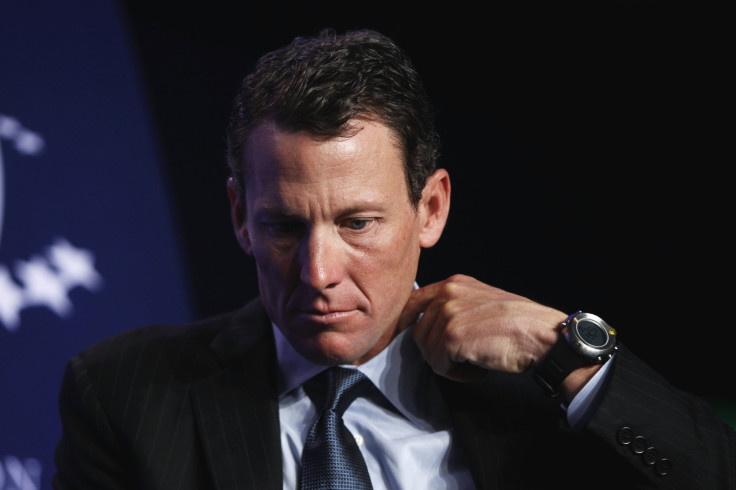Lance Armstrong Loses Titles; Will Doping Culture Change?

Lance Armstrong’s wardrobe will soon be missing several yellow jerseys. On Monday, the International Cycling Union stripped the famous cyclist of all seven of his Tour de France titles and banned him from the sport for life, adopting sanctions suggested by the U.S. Anti-Doping Agency.
Earlier this month, USADA released a massive report detailing evidence that Armstrong and his team were using performance enhancing drugs. 11 of Armstrong’s teammates on the U.S. Postal Service Pro Cycling Team came forward to testify. Armstrong still denies the allegations, pointing out he has never failed a drug test, but said in August that he would not defend himself against USADA charges.
Travis Tygart, the CEO of the USADA, said on Monday that UCI made the right decision. But for cycling to truly move past doping that is so widespread – so much so that the Tour de France will not transfer Armstrong’s lost titles to the next riders, most of whom have been caught up in doping scandals of their own – more details need to be uncovered and hard questions asked, Tygart said.
“Sanctioning Lance Armstrong and the riders who came forward truthfully should not be seen as penance for an era of pervasive doping,” Tygart said in a statement. “There must be more action to combat the system that took over the sport.”
Blood doping is one of the most common methods of illegal performance enhancement in modern cycling. Athletes can artificially increase the number of red blood cells in their bloodstream either through direct blood transfusion – from their own preserved blood or a compatible donor – or usually by taking the hormone erythropoietin, or EPO. EPO stimulates the formation of red blood cells and was originally developed to treat anemia.
According to Popular Science, many cyclists aim for a red blood cell proportion, or hematocrit, of just above 49 percent, just under testing regulations that throw up a red flag if a competitor passes 50 percent. They can add saline or plasma to their blood to even out the proportions if they overshoot.
More oxygen-carrying red blood cells means much greater stamina. A 1980 study in the Journal of Applied Physiology found that blood doping increased a person’s stamina by 34%; a 1981 paper found that a blood transfusion helped long-distance runners earn significantly faster times on a five-mile treadmill run. Elevated EPO levels in the brain can also improve athletic performance, according to a recent study in mice.
In addition to blood doping with transfusions and EPO, Armstrong is accused of taking testosterone to help build muscle tissue and corticosteroids to power through pain. He is also accused of taking masking agents to fool doping tests.
Some people argue that working against the engrained culture of doping in cycling and other professional sports is futile.
“If the goal is to protect health, then medically supervised doping is likely to be a better route,” says bioethicist Andy Miah said in an interview with Nature this past July. “Better yet, the world of sport should complement the World Anti-Doping Agency with a World Pro-Doping Agency, the goal of which is to invest in safer forms of enhancement.”
But another bioethicist, Thomas Murray, condemned the performance-enhancing arms race in his interview with Nature: “I could probably do a four-mile climb much better with EPO,” he says, “but I could also do it much better if I put a motor on my bike.”
In a 2008 debate over the acceptance of steroid use in sports hosted by the series Intelligence Squared U.S., several bioethicists argued in favor of loosening performance-enhancing drug restrictions on various grounds: sport itself is dangerous and is not banned; the whole concept of preventing adults from using drugs is paternalistic; and the perennial "everyone is already doing it" argument.
"Performance enhancement is not against the spirit of sport, it's been a part of sport through its whole history," University of Oxford ethicist Julian Savulescu said in the debate. "To be human is to be better, or at least to try to be better."
But on the opposing side, bioethicists and sports commentators say the culture is toxic and spreads to children.
"I don't want my kids, or your kids, or anybody's kids to have to turn themselves into chemical stockpiles just because there are cheaters out there who don't care what they promised when they started to participate," former World Anti-Doping Agency chairman Richard Pound said.
Scott Davis, who raced on the amateur circuit from the late 1980s to the late 1990s, says that while he never took performance enhancers himself or witnessed others taking them, it was well understood that most of the top-level cyclists were doping. Even before the advent of blood transfusions and EPO, cyclists were using methamphetamines and steroids.
“We had a coach that would say, ‘if you want to go pro, you can’t be scared of a needle,’” Davis said in a phone interview.
USADA’s Tygart wants to create a truth and reconciliation commission to be formed to probe deeper into doping practices and programs. Only further independent investigation can help cycling move past the EPO and blood doping era, he argues.
“There are many more details of doping that are hidden, many more doping doctors, and corrupt team directors and the omerta has not yet been fully broken,” Tygart said.
© Copyright IBTimes 2024. All rights reserved.











